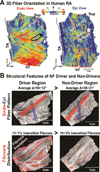Atrial fibrillation driver mechanisms: Insight from the isolated human heart
- PMID: 27492815
- PMCID: PMC5122472
- DOI: 10.1016/j.tcm.2016.05.008
Atrial fibrillation driver mechanisms: Insight from the isolated human heart
Abstract
Although there have been great technological advances in the treatment of atrial fibrillation (AF), current therapies remain limited due to a narrow understanding of AF mechanisms in the human heart. This review will highlight our recent studies on explanted human hearts where we developed and employed a novel functional-structural mapping approach by integrating high-resolution simultaneous endo-epicardial and panoramic optical mapping with 3D gadolinium-enhanced MRI to define the spatiotemporal characteristics of AF drivers and their structural substrates. The results allow us to postulate that the primary mechanism of AF maintenance in human hearts is a limited number of localized intramural microanatomic reentrant AF drivers anchored to heart-specific 3D fibrotically insulated myobundle tracks, which may remain hidden to clinical single-surface electrode mapping. We suggest that ex vivo human heart studies, by using an integrated 3D functional and structural mapping approach, will help to reveal defining features of AF drivers as well as validate and improve clinical approaches to detect and target these AF drivers in patients with cardiac diseases.
Keywords: Atrial fibrillation; Catheter ablation; Fibrosis; Intramural microanatomic reentry; Optical mapping; Reentrant driver.
Copyright © 2016 Elsevier Inc. All rights reserved.
Figures






Comment in
-
Editorial commentary: Mapping of persistent atrial fibrillation-Can the driver mechanisms be determined in the clinical setting?Trends Cardiovasc Med. 2017 Jan;27(1):12-13. doi: 10.1016/j.tcm.2016.06.006. Epub 2016 Jun 21. Trends Cardiovasc Med. 2017. PMID: 27425560 No abstract available.
References
-
- Nishida K, Nattel S. Atrial fibrillation compendium: historical context and detailed translational perspective on an important clinical problem. Circ Res. 2014;114(9):1447–1452. - PubMed
-
- Narayan SM, Krummen DE, Shivkumar K, Clopton P, Rappel WJ, Miller JM. Treatment of atrial fibrillation by the ablation of localized sources: CONFIRM (Conventional Ablation for Atrial Fibrillation With or Without Focal Impulse and Rotor Modulation) trial. J Am Coll Cardiol. 2012;60(7):628–636. - PMC - PubMed
Publication types
MeSH terms
Substances
Grants and funding
LinkOut - more resources
Full Text Sources
Other Literature Sources
Medical

